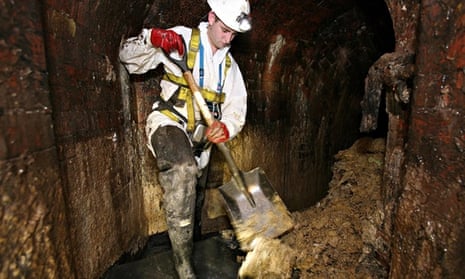Of all the divisions in the world, one of the most telltale (almost as dependable as a litmus test) must be that between those who know what a Buchan trap is and those who don’t. The knowledgable will almost certainly live in a particular age of house, built most probably between the 1870s and the 1930s, where they’ve been exposed to a particular kind of distress, one consequence of which is that the householder develops a lasting disbelief in the reality of the sewer scenes in The Third Man and Les Misérables. Too clean! But that’s the least of it.
A Victorian house is such a fragile thing. This has been a bad year for ours. The gutter sprang a leak, a bedroom ceiling collapsed, crushing the bed beneath with surprisingly heavy chunks of Victorian plaster, and in August the drains backed up and flooded the cellar with stinking grey slime. We weren’t there when it happened, nor 10 days later when it nearly happened again: house-sitters bore the brunt. Then in October, the same pattern: waste water’s clear reluctance to leave the premises in a hurry, a worry that it might burst up through the grating outside the cellar door. Men from Thames Water’s subcontractor came four times in all, and the full majesty of Thames Water itself turned up twice. “Buchan trap … Buchan trap”: the words began to haunt the street like “Queen’s gambit” in a chess class.
I knew from unhappy history that ours lay at seven or eight feet down at the bottom of a vertical pipe covered by a stone in the garden. The watermen always said the same thing: “First we’ll rod it, and if that doesn’t work, we’ll give it a blast with the hose.” The rodding never worked, though it was fun to watch the rod assembled like a chimneysweep’s brush and to hear the glug-glug from deep below as the waterman heaved it up and down. A glug-glug, but never followed by that suck-and-gasp of release that comes when a blockage is cleared and water once again runs towards the main sewer as freely as a brook. So the high-pressure hose would be uncoiled from the back of the van and the pressurising machine fired up and the hose poked down the pipe, to be twisted this way and that by the waterman – a skill in itself, to turn a pressure jet that’s eight feet away at the end of a non-rigid tube.
That cured it three of four times. Vasily, the Romanian who came twice, invited me to inspect the end of the jet’s nozzle after its last visit to the drain. I looked reluctantly at the solid matter attached. “Clay,” he said. “After the Buchan trap I’m hitting clay. Maybe the pipe has collapsed.” Short of digging up the street, the way to know for sure is usually to send down a camera that relays pictures to the workers on the surface, but the bends in the Buchan trap make this impossible. It prevents cameras going towards the main sewer just as it was designed to prevent cholera travelling in the opposite direction – from sewer to house.
Like so many other things displaced by the rush of progress, it is a Scottish invention.
WP Buchan, a Glasgow sanitary engineer (and no relation of the novelist so far as I know – The 39 Traps?), patented his device in 1875. Twenty years earlier, Dr John Snow’s research in Soho had shown that cholera wasn’t an airborne contagion – its source was contaminated water – but that didn’t immediately kill off the miasmatic theory of disease. Buchan designed his trap on the same principle as the water closet’s U-bend. By inserting a similar bend in the earthenware pipe that took sewage from the house, he created a water seal that prevented foul air escaping from the street’s main sewer into the house, where it might have laid low the inhabitants of every room. As an additional benefit it would also stop the ingress of rats. New building regulations insisted that the trap be installed in every house. Some were known as “interceptors” and others as “blind syphons”, and many took the names of their locality; the “Bristol interceptor” sounds like a car but is in fact a miserably filthy piece of fireclay buried outside many West Country homes. Hundreds of thousands were installed, and all in terms of their original purpose quite uselessly, because medicine lost its belief in miasmas and, as any waterman will tell you, rats can swim.
The Buchan trap, therefore, is as useless as an appendix or a tonsil, and like those human unnecessaries, is itself a source of problems and perhaps even of disease. They block too easily, causing overspills and floods, and began to give official concern more than 100 years ago; the government published a report in 1912. But, again, as per the appendix and tonsil, they only call attention to themselves when they go wrong, and a smell, at first puzzling and then disgusting, creeps up the cellar steps.
In fact, I don’t think our Buchan is the cause of the problem, which seems to lie downstream of it and probably under the piece of road that has subsided in the line of the drain. I sometimes point it out to the men who come and they say I may well be right. “Ah the Buchan trap! Ah Thames Water!” says a French neighbour, probably a banker, who has suffered from similar problems. “You ‘ave to call and call them and keep calling. Only then will something be done.” And so I keep calling. The last team who came promised to return with “an expert”. Two weeks have passed. Occasionally I turn on the kitchen tap and run outside and put my ear to the downpipe’s entrance to check that water is rushing below. Silence, a still pool that catches the torch’s beam: this is the worst news.
❦
I’m looking forward to a showing of Duck Soup at the BFI next week. Who can resist it? The mirror scene: “Remember, you’re fighting for this woman’s honour, which is probably more than she ever did!” … “This means war!” A film with some of the most treasured moments in cinema takes only 68 minutes from start to finish. Chaplin’s Modern Times lasts 87, Casablanca 102 and Citizen Kane 119 minutes – an “epic” narrative over and done in under two hours.
Now consider three recent releases: Leviathan, 140 minutes; Mr Turner, 150; Interstellar, 169. I was absorbed by the first two (I’m yet to see the third) and didn’t mind the length. Still, why does Mike Leigh need half an hour more to evoke JMW Turner’s life than Orson Welles took to evoke Charles Foster Kane’s? In an age of vanishing attention spans, the long film is a puzzling phenomenon. Nick James, editor of Sight & Sound magazine, thinks it has to do with the customer’s need to feel “value for money” – cinema seats are expensive – and expectations of more leisurely character and plot development that have been fostered by the box-set. An interesting effect is that one actually remembers less.

